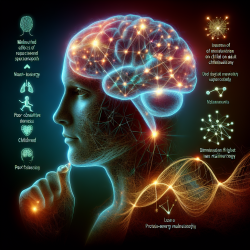Attention-deficit/Hyperactivity Disorder (ADHD) is a prevalent neurobehavioral disorder that significantly impacts children’s functioning across various settings. A recent study titled "Attention-deficit/Hyperactivity Disorder in Children: Clinical Profile and Co-morbidity" provides crucial insights into the clinical profile and co-morbidities associated with ADHD in Indian children. As a practitioner, leveraging these insights can enhance your therapeutic strategies and outcomes for children with ADHD.
Key Findings from the Study
The study analyzed 251 children referred to a Child Guidance Clinic over two years. Of these, 51 children met the inclusion criteria for ADHD diagnosis. Here are some key findings:
- Prevalence and Demographics: ADHD was diagnosed in 20.3% of referred children, with a male-to-female ratio of 6.3:1. The mean age was 5.7 years, with a majority from middle and lower socio-economic classes.
- Common Symptoms: Delayed speech and language development were common markers. The combined type of ADHD was the most prevalent.
- Co-morbidities: A staggering 86.3% of children had at least one co-morbid diagnosis, with learning disabilities being the most common.
- Socio-demographic Factors: Most children were first-born and raised in nuclear families.
Implementing the Research Insights
As a practitioner, here’s how you can implement these findings to improve your therapy outcomes:
- Early Identification: Pay close attention to early markers like delayed speech and language development, especially in preschool children. Early identification can lead to timely intervention.
- Comprehensive Assessments: Ensure thorough assessments to identify co-morbid conditions such as learning disabilities, anxiety disorders, and conduct disorders. Tailored interventions addressing these co-morbidities can significantly improve overall outcomes.
- Parental Involvement: Engage parents in the therapeutic process. Educate them about ADHD and its associated conditions. Parental understanding and support are crucial for effective management.
- Socio-demographic Considerations: Be mindful of socio-demographic factors. Children from nuclear families or lower socio-economic backgrounds may require additional support and resources.
- Multidisciplinary Approach: Collaborate with other professionals such as pediatricians, psychologists, and special educators to provide holistic care.
Encouraging Further Research
While the study offers valuable insights, there is always room for further research. Practitioners are encouraged to:
- Conduct longitudinal studies to track the persistence of ADHD symptoms and co-morbidities over time.
- Explore the impact of different therapeutic interventions on various ADHD subtypes and co-morbid conditions.
- Investigate the socio-cultural factors influencing ADHD diagnosis and management in different populations.
Conclusion
ADHD is a complex disorder with diverse presentations and co-morbidities. By incorporating data-driven insights from recent research, practitioners can enhance their therapeutic strategies and create better outcomes for children with ADHD.
To read the original research paper, please follow this link: Attention-deficit/Hyperactivity Disorder in Children: Clinical Profile and Co-morbidity.










